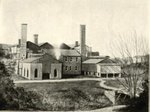


The irony is impossible to escape.
As many as 30 young Irish immigrants fled their homeland during the Great Famine only to die here from cholera, their common grave unmarked — until a few years ago.
It was July 1849 — Upper Bucks in the time of cholera — and the Durham Iron Co. had just built its first furnace. It was the third year of the third cholera pandemic and the iron company’s first full year.
The famine had killed a million people in Ireland from 1845 to 1851. Cholera, medical records show, had come in waves, first traveling from India to Europe, and claiming thousands of American lives during the years 1846 to 1860.
The sad story of workers at the Durham Iron Co. and a few others lives on, thanks to two local history buffs.
Dr. James McHugh, of Nockamixon Township, an emergency room physician, was so touched when he learned of the tragedy, he found a way to ensure the dead are remembered. He knew nothing about it, he said, until an associate sent him some 1849 newspapers documenting the epidemic at Durham Furnace. Even so, the information was far from complete. McHugh explained cholera is “a bacterial illness spread through contaminated water and food supplies.”
McHugh created a memorial at Old St. John the Baptist Cemetery where, he said, the bodies of the Irish Catholic dead “were taken under the cover of night and buried in trenches without religious ceremony” more than 170 years ago.
James Walter, a retired research and development engineer, who works tirelessly as a volunteer with the Durham Historical Society, discovered the tragedy while he was examining township history with an eye to the 19th Century coal-burning furnace on Route 212. It’s a special interest of his. Owned by Joseph Whitaker, the company had just built a new furnace and had hired Irish workmen.
With information from both men, who don’t know each other, I was able to pull together a story about what happened 174 years ago.
Walter’s research was able to pinpoint the beginning of the local epidemic. He said cholera was believed to have been first carried to Durham by an infected man aboard a canal boat.
“The lock tender, named Huff or Hough, looked in on him, contracted the disease and died. Samuel F. Hartman, who had cared for the lock tender, escaped sickness, but his 19-month-old son died,” Walter said.
Most of the infected, Walter said, died in a log barn, where the wives of the workmen braved death in nursing the sick and preparing the dead for burial.
Some neighbors were so badly alarmed they either fled or would not go near the iron works. Later, though, they cared for the widows and orphans left behind.
Among what the newspapers of the times called “a noble set of women,” were Mrs. Bryan Riley, Mrs. Caffrey, Mrs. Reaney, Mrs. Demster, Mrs. Terrence Riley, Mrs. Hartman and Mrs. Young.
Men who helped, in addition to Hartman, were Edward Keelon, John Young and Thomas and Farrel Riley. “Keelon,” Walter said, “attended every funeral at Durham until his death in 1899.
The Catholic families wanted their dead buried in sanctified ground and that’s why they were taken to St. John’s.
James Stevens, the only non-Catholic, was buried behind the home of James Pennypacker, superintendent of the iron works. When Pennypacker closed down the furnace he stayed behind with a small group to care for the sick. Several years later, though, he, too, died of cholera.
The blessing of the monument at St. John’s took place on All Souls Day in 2017. It’s engraved with the words, “Lord, have mercy,” in the Irish language, along with the images of two Celtic crosses.
It honors the memory of “the Riley family and the nameless Irish immigrants from the Durham Furnace….” McHugh said the name Riley is on the stone because he was sure at least one Riley was buried there. A memorial plaque in memory of McHugh’s parents, Jack and Ellen McHugh, lies in front of the monument. Both memorials were a gift from the 11 McHugh children. Their parents were longtime members of the parish.
Dr. McHugh has also personally restored and preserved a number of the historic tombstones in the cemetery which dates from 1742. He said no one knows where the trench was dug.
Nameless or not, the victims are remembered.
Kathryn Finegan Clark is a freelance writer who lives in Durham Township. She can be reached at kathyclark817@gmail.com.
Join our readers whose generous donations are making it possible for you to read our news coverage. Help keep local journalism alive and our community strong. Donate today.